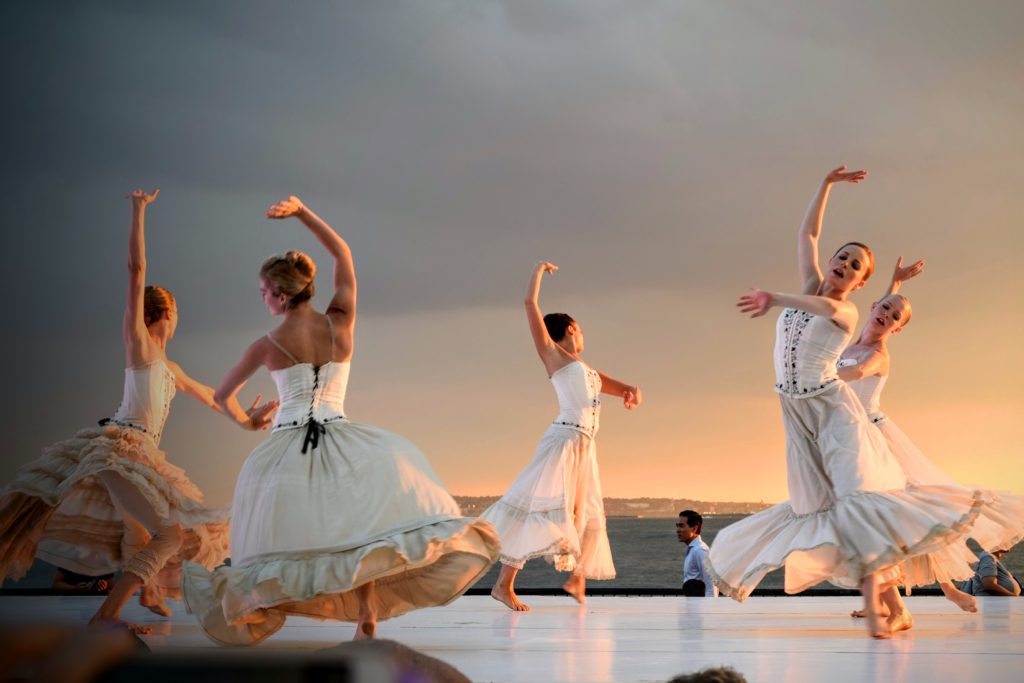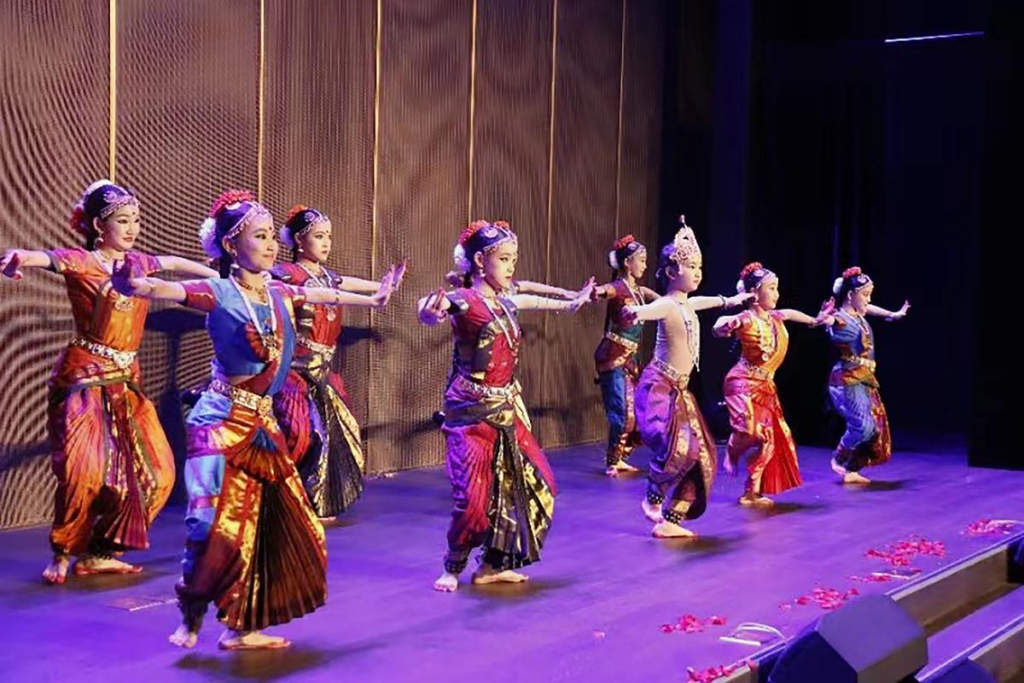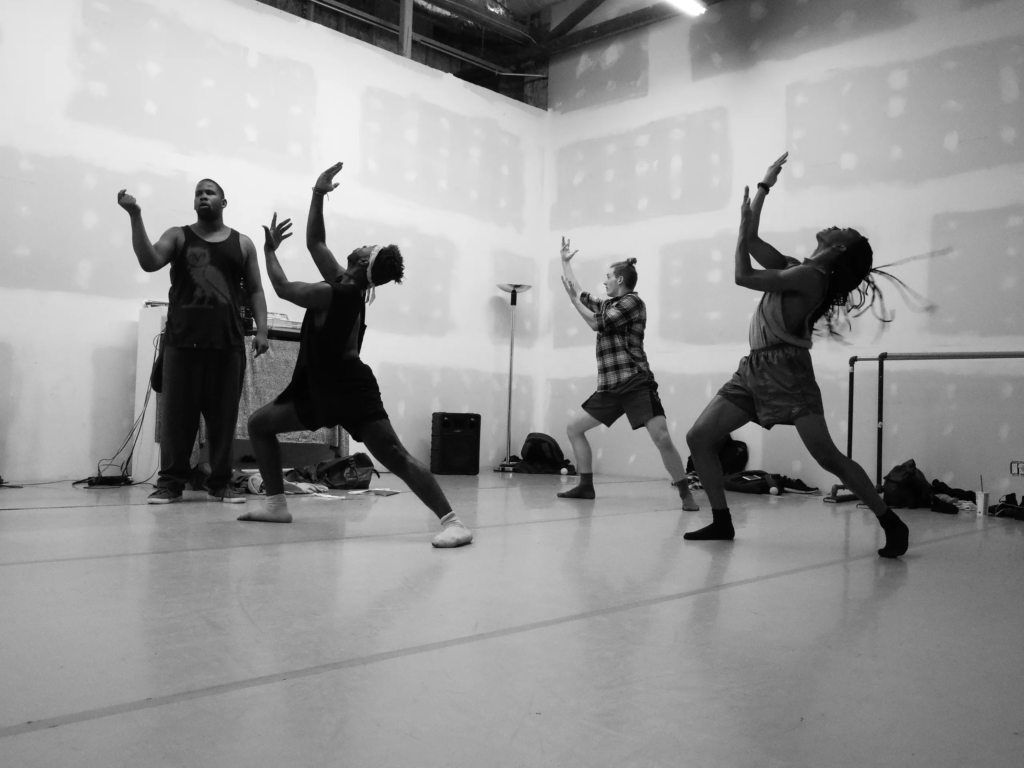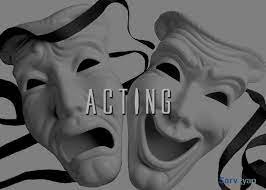Dancer (1 years course)
Dancer click here
Brief Job Description: A Dancer is an artistic performer who uses moves rhythmically
according to music, using prescribed or improvised steps and gestures to tell stories
and convey emotions. Professional dancers will perform in group as well as solo and
play an essential role in many music videos, live performance, capturing the
audience’s imagination and enhancing their audio-visual experience.

Personal Attributes: An individual in this job needs to be health conscious, aware of
basic rhythmic patterns to create dance form. He/she must be physically fit and must
be able to follow the steps suggested.
Qualifications Pack For Dancer
Keywords /Terms
Description
Accessories Anything carried or worn on top of the basic costume for decorative purposes,
e.g. a shawl, a purse.
Asymmetry A shape made by a dancer or dancers that has no line of reflection (mirror
line).
Call sheet a daily schedule of filming for a movie or television show
Computer-generated
effects
Computer-generated effects is the process of creating illusionary images for
use in productions
Continuity Continuity represents the seamless transition from one shot to another
Costume Is the distinctive style of dress of an individual or group that reflects their class,
gender, profession, ethnicity, nationality, activity or epoch.
Copyright Laws A legal framework linked to intellectual property and the rights given to
creators of original products/ concepts
Creative Brief Creative brief is a document that captures the key questions that serve as a
guide for the production including the vision, objective of the project, target
audience, timelines, budgets, milestones, stakeholders etc.
Digital Intermediate Digital Intermediate is the process of altering the colour characteristics of a
digital version of the production
Editing Editing is the process of cutting, organising and putting together audio, visual
footage to prepare an accurate, condensed and consistent final output
Improvisation Spontaneous movement in response to a stimulus.
Ingest Ingest is the process of importing the relevant audio visual files and/or
images to the computer’s hard disk and uploading them to the editing
software
Job role Job role defines a unique set of functions that together form a unique
employment opportunity in an organization.
Melody A succession of notes forming a distinctive sequence; the tune.
Mirroring technique in choreography where dancers perform dance facing each other
and doing the same dance.
Narrative structure A choreographic structure that tells a story.
Improvisation Spontaneous movement in response to a stimulus.

Editing Editing is the process of cutting, organizing and putting together audio,
visual footage to prepare an accurate, condensed, consistent final output
Job role Job role defines a unique set of functions that together form a unique
employment opportunity in an organization.
National Occupational
Standards (NOS)
NOS are Occupational Standards which apply uniquely in the Indian context.
Occupation Occupation is a set of job roles, which perform similar/related set of
functions in an industry
Occupational
Standards (OS)
OS specify the standards of performance an individual must achieve when
carrying out a function in the workplace, together with the knowledge and
understanding they need to meet that standard consistently. Occupational
Standards are applicable both in the Indian and global contexts.
Performance Criteria Performance Criteria are statements that together specify the standard of
performance required when carrying out a task
Qualifications Pack For Dancer
Personal space The “space bubble” around the body, extending as far as the body and body
parts can reach, without travelling
Qualifications Pack
Code
Qualifications Pack Code is a unique reference code that identifies a
qualifications pack.
Qualifications
Pack(QP)
Qualifications Pack comprises the set of OS, together with the educational,
training and other criteria required to perform a job role. A Qualifications
Pack is assigned a unique qualification pack code.
Quick change any costume change completed when an actor has a limited amount of time,
sometimes as few as twenty seconds.
Rehearsal A practice or trial performance of a play or scene.
Repetition A choreographic device in which movements or motifs are repeated.
Retrograde Performing a sequence of dance moves in reverse order
Rhythm Regular re-occurrence of the accented beat.
Script Script is a structured narrative of a story
Sector Sector is a conglomeration of different business operations having similar
businesses and interests. It may also be defined as a distinct subset of the
economy whose components share similar characteristics and interests.
Shooting schedule Is a project plan of each day’s shooting for a film production.
Shutter A mechanism in the camera that controls the duration of transmission the
light that reaches the film or sensor.
Silhouette The dark shape and outline of someone or something visible in restricted
light against a brighter background.

Sub-functions Sub-functions are sub-activities essential to fulfill the achieving the
objectives of the function.
Sub-sector Sub-sector is derived from a further breakdown based on the characteristics
and interests of its components.
Symmetry A shape made by a dancer or dancers that has a line of reflection (a mirror
line).
Target Audience Group of people at whom content/ adverting is aimed.
Tempo The rate of speed of the music.
Time Lapse A series of photographs captured over a period of time. These images can
be captured in variable or set time intervals over the course of seconds,
minutes, hours, days, weeks, etc.
Timelines Timelines is a listing of dates by which the production milestones/stages
need to be completed
Visual style Visual style comprises the look or appearance of the production including
the lighting, colours, shadows, sets, costumes, locations and the way they
will be captured on screen.
Wardrobe The costumes of a theatre or theatre troupe, also the room or department
in which they are made, and in some cases, stored.
Description
NOS National Occupational Standard(s)
NSQF National Skills Qualifications Framework
QP Qualifications Pack
Acroynyms
NVEQF National Vocational Education Qualifications Framework
Recognise dance as an artform
Description This unit is about different elements of dance, steps and valuing dance as an
artform through the study of the performance, composition and appreciation
of dance.
Scope This unit/task covers the following:
Follow elements of dance composition.
Recognize the diversity of dance as an artform
Performance Criteria (PC) w.r.t. the Scope
Element Performance Criteria
Follow elements of
dance composition
To be competent, the Dancer must be able to:
PC1. link rhythm (beats) and dance in constant time and space
PC2. dance in time and perform in different rhythmic expressions
PC3. identify the body’s capabilities and limitations
PC4. perform dance with confidence, commitment, focus, consistency, and
with due consideration of safe dance practices.
PC5. identify the elements of dance composition and perform the steps of
dance in group as well as in solo dance form
PC6. sync steps with other dancers
PC7. dance in free style
PC8. perform as per the indicated theme (traditional pattern, hip-hop,
contemporary)
PC9. structure the compositional processes of various dance forms.
PC10. train, exercise, and attend dance classes to maintain high levels of
technical proficiency, physical ability, and physical fitness.
Recognize the
diversity of dance as
an artform
PC11. express dance as an artform wherein the body is the instrument for
non-verbal communication and expression.
PC12. identify dance from artistic, aesthetic and cultural perspectives
through movement, written and oral form.
PC13. study and practice dance moves required in roles.
Knowledge and Understanding (K)
A. Organizational The Dancer on the job needs to know and understand:
KA1. dance as an integral component of every known culture, providing a
medium of expression and an extension of work and lifestyle patterns.
KA2. how dance provides a way of knowing about oneself, other people
and the world.
B. Technical Knowledge
The Dancer on the job needs to know and understand:
KB1. elements of dance relating to dance compositions.
KB2. different forms of dance – classical, western dance etc. (classical
dance types – Bharatanatyam, Kathak, Kuchchipudi, Odishi etc.)
KB3. steps and lyrics in various kinds of dance like jhak teen tak, tai tha thai,
one two three etc.
KB4. how to recognise the importance of the application of safe dance
practice.

KB5. the need for self-discipline, commitment and consistency in
performance.
Skills (S) (Optional)
A. Core Skills Writing Skills
The Dancer needs to know and understand how to:
SA1. write rhythm beats / steps in sequence
SA2. take note of directions given by choreographer
Reading Skills
The Dancer needs to know and understand how to:
SA3. read steps indicated by choreographer, musicians
SA4. study cultural background to perform in artistic form
Oral Communication (Listening and Speaking skills)
The dancer needs to know and understand how to:
SA5. discuss regional / cultural evidences of an artform
SA6. make discriminating judgments about dance
B. Professional Skills Plan and Organize
The dancer needs to know and understand how to:
SB1. manage schedules within the agreed budget and minimize overruns
Problem Solving
The user/individual on the job needs to know and understand how to:
SB2. identify any problems with successful execution of the task and
resolve them in consultation with the production team
Critical Thinking
The user/individual on the job needs to know and understand how to:
SB3. appraise the quality of the raw footage shot to ensure it is in line with
the initial concept and program requirements
SB4. manage time and space available for stage performance whether in
group dance or in solo dance
Decision Making
The user/individual on the job needs to know and understand how to:
SB5. use a variety of thinking skills to analyze and evaluate different dance
forms.
SB6. do historical , musical and movement research for a new dance work
before beginning to work with the dancers.
Analytical Thinking
The user/individual on the job needs to know and understand how to:
SB7. have a keen eye for detail and maintain an aesthetic sense towards
the final output
Customer Centricity
The user/individual on the job needs to know and understand how to:
SB8. check that your own work meets program requirements
Follow choreography elements
Description This unit is about following choreography steps and its application while
dancing in group and solo piece.
Scope This unit/task covers the following:
Follow aspects of choreography
Performance Criteria (PC) w.r.t. the Scope
Element Performance Criteria
Follow aspects of
choreography
To be competent, the Dancer must be able to:
PC1. identify dance as an art form and relate dance to historical and
cultural contexts
PC2. present polished dance works using technical skills and artistic
expression
PC3. apply reflective practices in order to identify processes for further
development
PC4. analyse and document dance-making processes
PC5. assess the effectiveness of a range of dance works of others
PC6. use terminologies relevant to dance performance and choreography
PC7. identify and appropriately react to potential hazards in a dance
environment, and appropriately apply safe dance principles and
practices
PC8. identify and apply the structure of dance works
PC9. manage the duration of the movement
PC10. use/exhibit different energy levelsto reveal different emotional states
PC11. demonstrate the ability to relate to other dancers and objects
PC12. demonstrate an understanding about movements
PC13. analyse available space; low floor moves, medium standing moves
and high leaping and lifting moves
PC14. form/make patterns of circles, squares, triangles, etc. with groups of
people, or by moving at space(through the air or across the floor)
PC15. judge how fast or slow the movements must be to match tempo and
beat of the song/music/audio
PC16. articulate when movements are meant to be slow, fast, in a wave or
hit
PC17. initiate movements and establish who is leading and following while
dancing in a group and able to change partner
PC18. show variations of how large or small are the movements in the space
PC19. take sight cues from other dancers to start the next phase or use
shared awareness of sensed time to end a dance
PC20. exhibit variations in energy which are easy to identify
Knowledge and Understanding (K)
A.Organizational
Context (Knowledge
of the company /
organization and its
processes)
The Dancer on the job needs to know and understand:
KA1. the history of Gharanas from which dance was originated and its
importance in specific cultural aspects.
KA2. elements of dance conserved by the organisations
B. Technical Knowledge
The Dancer on the job needs to know and understand:
KB1. the outer realm of expression and communication.
KB2. choices about energy including variations in movement flow and use
of force, tension, and weight.
KB3. that the elements of dance are part of the foundational concepts
that dancers must practice.

KB4. any human movement/action can be included in the act of
dancing— dance steps, facial movements, lifts, carries etc.
KB5. energy level to be displayed
Skills (S) (Optional)
A. Core Skills/
Generic Skills
Writing Skills/Design Skills
The individual on this job needs to know how to:
SA1. write count for each steps of dance
SA2. visualize and design a floor pattern for dance composition and having
a beginning and ending point
Interpersonal Skills
The individual on this job needs to know how to:
SA3. enter into another character and engage with an audience
SA4. apply dramatic techniques and memorise lines
Oral Communication (Listening and Speaking skills)
The individual on this job needs to know how to:
SA5. communicate with other dancers through a guided movement
B. Professional Skills Decision Making
The user/individual on the job needs to know and understand how to:
SB1. use a variety of thinking skills to analyze and evaluate different dance
forms.
Plan and Organize
The user/individual on the job needs to know and understand how to:
SB2. manage schedules within the agreed budget and minimize overruns
Problem Solving
The user/individual on the job needs to know and understand how to:
SB3. identify any problems with successful execution of the task and
resolve them in consultation with the production team
Analytical Thinking
The user/individual on the job needs to know and understand how to:
SB4. have a keen eye for detail and maintain an aesthetic sense towards
the final output
Critical Thinking
The user/individual on the job needs to know and understand how to:
SB5. appraise the quality of the raw footage shot to ensure it is in line with
the initial concept and project requirements
Customer Centricity
The user/individual on the job needs to know and understand how to:
SB6. check that own work meets project requirements
Perform dance
Description This unit is about how knowledge of body, understanding of music and lyrics,
and skills of choreography are followed in performing dance.
Scope This unit/task covers the following:
Align dance as per lyrics, music and song
Perform dance as per choreography steps
Performance Criteria (PC) w.r.t. the Scope
Element Performance Criteria
Align dance as per
lyrics, music and Song
To be competent, the dancer must be able to:
PC1. perform dance in different dance forms
PC2. change appearance as per dance requirement
PC3. demonstrate appropriate skeletal alignment, body-part articulation,
strength, flexibility, agility and coordination.
PC4. harmonize body movements to rhythm of musical accompaniment.
PC5. perform classical, modern, or acrobatic dances in productions,
expressing stories, rhythm, and sound with their bodies.
PC6. collaborate with choreographers to refine or modify dance steps.
PC7. coordinate dancing with that of partners or dance ensembles
PC8. attend costume fittings, photography sessions, and makeup calls
associated with dance performances.
PC9. develop self-understanding of physical capabilities and limitations,
and choose dance styles accordingly.
PC10. deal with flexibility of body, mental, emotional status and how to deal
with stress, long rehearsals.
PC11. differentiate between rhythm, tempo, melody and timing.
PC12. realize different time signatures (or meters), and how that will affect
the dance.

PC13. demonstrate the characters in the song, concept, dance style.
PC14. follow movements of the choreographer
PC15. express attitude, body language, style, performance capability,
timing, etc.
PC16. display the mood and tempo of the song throughout and in multiple
takes
PC17. follow the movement, phrases, transitions and sequences designed by
the choreographer.
PC18. follow the emotions, the choreographer is trying to express.
PC19. analyze the concept of scene, shots, takes and continuity.
PC20. dance according to the beat and maintain it consistently throughout
the dance or takes.
PC21. follow the style composed by the choreographers for a particular
song
PC22. follow the positions and placements to create formations.
PC23. perform in coordination with the patterns, change the patterns speed,
reverse the pattern, communicating and notating movements of
other dancers with patterns.
PC24. align the context-the situation, the scene, the conditions, and
background within which he/she is performing.
PC25. perform by maintaining uniformity and in sync with co-dancers
PC26. dance under different climatic conditions, locations or as per the
requirements of the choreographed sequence, as long as it doesn’t
physically harm the dancer
PC27. accept spot improvisation and adapt it accordingly.
PC28. adopt the theme of the performance and choose the costume
accordingly.
Knowledge and Understanding (K)
A. Organizational
The Dancer on the job needs to know and understand:
KA1. target audience and their tastes and preferences
KA2. program schedule and timelines
KA3. how to respect the art, the studio space, their teachers, their fellow
dancers and the creative process
KA4. importance of physical stamina to endure long periods of standing,
dancing, singing or other physically taxing activities.
B. Technical
Knowledge
KB1. The Dancer needs to know and understand:
KB2. performing arts and cinematic storytelling
KB3. the basic principles of film-making, stage or television performance
production
KB4. different dance forms and techniques
KB5. the style associated with a particular song, particular performer,
performance group, choreographer or period.
KB6. how to mentally associate certain steps with strong beats or lyrics of
the song.
KB7. how to count using numbers and letters to signify different accents
and movements
KB8. basic costume and makeup skills and able to do touch up and maintain
continuity
KB9. set, props, lighting and mood of location
KB10. applicable health and safety guidelines
KB11. theory and techniques required to compose, produce, and perform
works of music, dance, visual arts, drama, and sculpture.
KB12. principles and methods for curriculum and training design, teaching
and instruction for individuals and groups, and the measurement of
training effects.
KB13. media production, communication, and dissemination techniques and
methods. This includes alternative ways to inform and entertain via
written, oral, and visual media.
Skills (S) (Optional)
A. Core Skills/
Generic Skills
Writing Skills
The user/individual on the job needs to be able to:
SA1. write steps suggested by choreographers and dance moves/steps.
Reading Skills
The user/individual on the job needs to be able to:
SA2. read the lyrics or song concept
Perform dance
SA3. research the profile and preferences of the target audience
SA4. research creative and innovative ways to represent the contest
through dance
SA5. study new and emerging types of dance
Oral Communication (Listening and Speaking skills)
The user/individual on the job needs to know and understand how to:
SA6. be able to communicate with co performers and lead performers.
SA7. support and cheer the lead dancers, lead actors, lead performers.
B. Professional Skills Plan and Organize
The user/individual on the job needs to know and understand how to:
SB1. plan to organize stage show as and when required
Problem Solving
The user/individual on the job needs to know how to:
SB2. match the steps with co-workers while performing without re-take
while performing in live show
SB3. be ready to listen to critics
Critical Thinking
The user/individual on the job needs to know how to:
SB4. appraise the quality of own work to ensure it is in line with the
expected quality
Decision Making
The user/individual on the job needs to know how to:
SB5. decide to perform in group or solo
Analytical Thinking
The user/individual on the job needs to know and understand how to:
SB6. have a keen eye for detail and maintain an aesthetic sense towards
colour, shapes and forms of the final output
Customer Centricity
The user/individual on the job needs to know and understand how to:
SB7. adapt to the different disciplines of TV, film and theatre
Develop and maintain portfolio
Description This unit is about exploring the opportunity to work in media &
entertainment industry as artistic professional.
Scope This unit/task covers the following:
Create portfolio
Approach industry to avail opportunities
Performance Criteria (PC) w.r.t. the Scope
Element Performance Criteria
Create portfolio To be competent, an artist must be able to:
PC1. prepare portfolio, recording, show reel, etc.,
PC2. choose best headshots and performance shots to showcase
PC3. create unique portfolio which speaks to a range of audiences
PC4. apply social media network like youtube / linkedin for promotional
purposes
Approach industry to

avail opportunities
PC5. promote themselves through networking
PC6. approach associations for becoming a member
PC7. approach clients (producers /casting directors / dance director etc.) in
a professional manner
PC8. be on time and in suggested dress for audition / presentation
PC9. be ready to cold-read as per project requirement(s) in line with the
expertise
PC10.be ready for presentation /screen test, voice test etc., wherever
required during audition/interviewing
PC11.negotiate for remuneration of contract / work order aligned with the
assignments
PC12.recognize common components of an assignment contract including
term and duration of project
PC13. collaborate with others to determine technical details of production
An artistic professional on the job needs to know and understand:
KA1. brand value of the business /production houses
KA2. relavent designing / distribution policy of India
KA3. relavent guidelines defined by Government like broadcasting guideline
of Ministry of Information and Broadcasting
KA4. legal framework pertaining to design, film, television etc.
B. Technical
Knowledge
An artistic professional on the job needs to know and understand:
KB1. how to familiarize with the content of the assignments (design /script
etc.)
KB2. industry personnel and terminology, interview, audition and screen
test processes and the role of agents, contracts, payments, insurance.
KB3. how to negotiate a professional contract for his services, including an
understanding of payments, taxation, convergence rate and other legal
matters
KB4. about the risk involved in getting work orders in case of freelancing
KB5. how to update of portfolio in line with change in technology vs
increase in experience.
KB6. relevant industry association / forum whom individual will approach
while in professional trouble
KB7. role of marketing and distribution in ensuring the chances of
commercial success, including the role of individuals involvement
KB8. principles and methods for showing, promoting, and selling products
or services, including, marketing strategy and tactics, product
demonstration, sales techniques, and sales control systems.
KB9. arrangements and equipment for a design / shoot, whether lab or
studio set or location, indoors or outdoors, with regard to set,
premises, cameras, lighting, set furniture and props, costumes and
makeup.
KB10.business and management principles involved in strategic planning,
resource allocation, human resources modeling, leadership technique,
production methods, and coordination of people and resources
KB11.media production, communication, and dissemination techniques and
methods, including alternative ways to inform and entertain via
written, oral, and visual media.
KB12.principles and methods for showing, promoting, and selling products
or services. This includes marketing strategy and tactics, product
demonstration, sales techniques, and sales control systems.
KB13.responsibility of each person on the production floor as they affect the
individual performance.
KB14.process of dubbing and voice-over work etc. wherever applicable
KB15.performance in a local language when required







